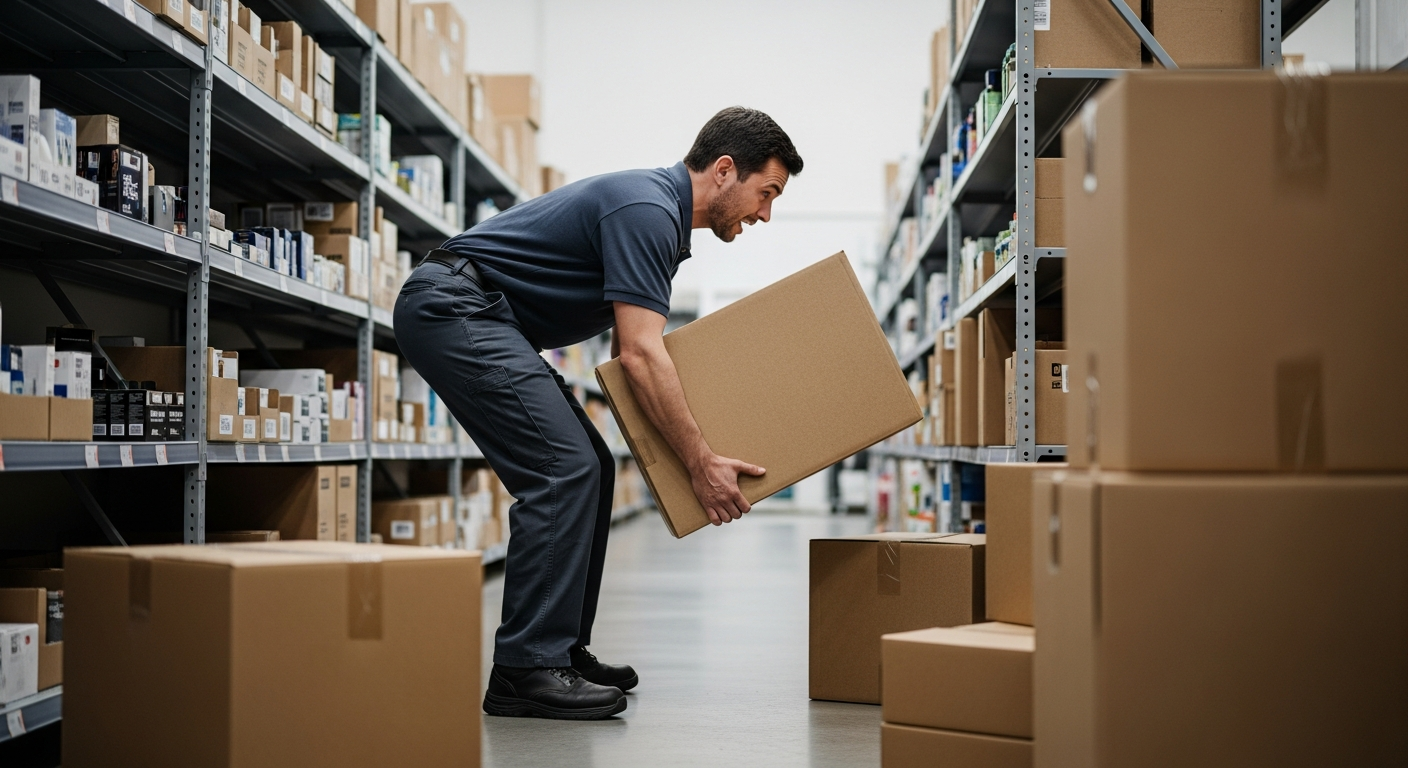For retail safety leaders, the numbers are sobering: Retail workplaces reported 422,700 nonfatal injuries and illnesses in 2023, with an injury rate of 3.7 cases per 100 full-time workers—outpacing the national average for all industries (Source: Bureau of Labor Statistics, 2023). These foreseeable and often addressable injuries are not only common but also costly.
These incidents are more than statistics. They mean lost workdays, substantial direct costs, and even higher indirect costs—think productivity loss, team disruption, and reputational hits.
Fortunately, most of the top injuries in retail can be mitigated. By combining established safety best practices with new technology—especially video AI—retailers can identify risks as they emerge, reinforce compliance, and empower frontline teams to act fast.
In this guide, we’ll break down the top 3 common injuries in retail facilities and, most importantly, how to guard against them. We’ll show how video analytics complements safety programs, supporting your people and your bottom line.
The top 3 common injuries in retail (and how to mitigate them)
The 3 injury types that consistently top the charts in U.S. retail are where video AI offers a clear, direct mitigation benefit. For each, we’ll walk through a real-world scenario, root causes, and practical tech-supported solutions.
1. Overexertion injuries (lifting, carrying, pushing)
Scenario:
During a busy delivery, an employee lifts a 60-pound box (well above the recommended limit), twisting awkwardly to fit it onto a high shelf. They strain their back, resulting in weeks off work.
Root Causes & Impact
Impact: Overexertion is the single largest driver of retail injuries. Back injuries and strains can be costly and often lead to chronic issues.
How video intelligence helps:
Video AI systems can flag improper lifting techniques and non-compliance with safe handling protocols. Managers can review clips to coach individuals, identify patterns (like frequent manual lifting in certain shifts), and verify that assistive devices are used in real time.
2. Struck-by-object incidents
Scenario:
A stockroom shelf is overfilled and lacks proper load signage. When an employee grabs one box, several others tumble down, striking their head and hand.
Root Causes & Impact
Impact: Struck-by-object injuries are a major cause of retail incidents, commonly resulting in fractures, lacerations, or concussions with high associated costs.
How video intelligence helps:
Video AI cameras monitor shelving and pallet areas for unsafe stacking, blocked safety zones, or violations of racking protocols. They can trigger alerts when someone enters a high-risk area without PPE or when unsafe loading is detected.
3. Machine-related injuries (cutting, pinching, amputations)
Scenario:
During a rush, an employee disables a slicer’s safety guard to speed up sandwich prep. Their hand slips, resulting in a severe laceration and partial fingertip amputation.
Root Causes & Impact
Impact: Hands and fingers are the most commonly injured body parts in retail, with lacerations and amputations leading to considerable direct costs per incident.
How video intelligence helps:
Video AI can be used to create no-go zones around dangerous machinery, alerting supervisors if anyone enters an unsafe area. The footage also offers a clear record for investigations and training, helping to verify that safety protocols, like the use of machine guards, are being followed.
Pain points and impact of these injuries in retail
These three injury types impact retail operations in several ways, and video technology can help address them:
How technology strengthens injury mitigation in retail
Video AI strengthens safety programs. Here’s how it supports each injury type—making retail workplaces safer and more insight-driven.
Overexertion injuries
Safety hurdle: Unsafe lifting and skipped ergonomic protocols often go unnoticed until someone is hurt—or develops chronic pain.
Tech Solution: Spot AI’s searchable video simplifies incident review and investigate the root causes of overexertion injuries. By analyzing footage of high-risk tasks, leaders can identify non-compliance with ergonomic protocols—such as staff ignoring assistive devices—and apply these insights to targeted coaching, helping enforce safe lifting policies without hovering over staff.
Struck-by-object incidents
Safety roadblock: Stockrooms and aisles get crowded. Overstocked shelves, missing signage, or unsafe stacking can lead to dangerous moving-object events.
Tech Solution: Video AI can be used to enforce safety protocols in storage areas. By setting up “no-go zones,” the system can alert supervisors when someone enters a restricted area, such as near unstable shelving or during forklift operations. Reviewing video also helps spot trends—like certain shifts with more safety violations—so you can adjust training or layout.
Machine-related injuries
Safety hurdle: Shortcuts—like disabling guards or rushing machine tasks—are tempting but dangerous. Traditional supervision can’t catch every unsafe act.
Tech Solution: Video AI can be configured to create danger zones around machinery. If a person enters this restricted area, the system can send a real-time alert to prompt on-the-spot intervention. Searchable video also helps compliance teams verify that safety guards are properly used and target refresher sessions where they’re most needed.
Practical implementation of safety technology in retail
Implementing safety technology in a retail environment is about empowering your teams, not replacing them. Follow these key steps for a successful rollout:
When evaluating solutions, ask vendors for case studies in retail, check for easy integration, and prioritize user-friendly platforms for frontline managers.
Strengthen your retail safety program
Mitigating injuries keeps your team whole, ensures operations run smoothly, and maintains customer satisfaction. Leading retailers are seeing fewer injuries and more engaged staff by combining proven protocols with video intelligence.
See how Spot AI’s video AI platform can help you reduce incidents and build a stronger safety culture. Request a product demo to experience the technology in action.
Frequently asked questions
How can video AI help reduce the likelihood of injuries in a retail environment?
Video AI systems can detect events like people in restricted areas in real time. The footage can then be reviewed to identify hazards like spills or protocol violations. They alert staff or supervisors rapidly, help verify that safety procedures are followed, and provide valuable footage for training and root-cause analysis.
What steps should I take to implement video AI in my retail store?
Start by identifying your highest-risk areas (stockrooms, aisles, checkout). Integrate video AI with your existing camera system, train managers on how to use alerts and search features, and combine tech with your regular safety meetings and training.
How do I choose the right safety technology for my retail business?
Look for solutions that integrate with your current cameras, are easy for frontline managers to use, and address your most frequent injury types. Ask vendors for proven retail case studies and prioritize platforms with strong analytics and alerting features.
Can video AI replace traditional safety training or inspections?
No—technology works best when layered onto a foundation of strong safety culture, regular training, and routine inspections. Use video AI to enhance, not replace, your human-led safety efforts.
What makes a video analytics system effective for workplace safety?
The most effective systems provide actionable intelligence, not just passive monitoring. Look for real-time alerts for events like intelligent search to find specific incidents quickly, analytics that identify risk "hot spots," and the ability to integrate with your existing cameras. A user-friendly interface for frontline managers is also crucial.
About the author
Joshua Foster is an IT Systems Engineer at Spot AI, where he focuses on designing and securing scalable enterprise networks, managing cloud-integrated infrastructure, and automating system workflows to enhance operational efficiency. He is passionate about cross-functional collaboration and takes pride in delivering robust technical solutions that empower both the Spot AI team and its customers.

























.png)
.png)
.png)